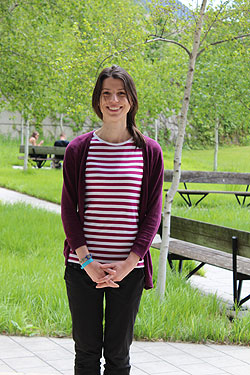
Isabella Finco
Visiting Scholar
I first joined the Hammer lab as visiting scholar, through the International Endocrine Scholar Program (IESP) of the Endocrine Society. I was enrolled at the University of Padua in the PhD program in "Clinical Methodology and Endocrine Sciences", under the mentorship of Prof. Franco Mantero. In Prof. Mantero's lab, I was studying the effects of somatostin analogues on adrenal tumors and on the angiogenesis, in particular of SOM230 on adrenocortical carcinomas, cortisol-secreting adenomas and aldosterone-secreting adenomas. I currently am working on the role of the Sonic hedgehog pathway in the adrenal gland regeneration.
Adrenal regeneration
Clinical adrenocortical suppression following the chronic administration of supra-physiologic glucocorticoids is a major and frequent health problem because the adrenal cortex remains atrophied for weeks to months, leaving patients dependent upon exogenous steroid replacement therapy for long periods of time until the adrenal cortex regenerates following medically supervised glucocorticoid withdrawal. The molecular and cellular mechanisms of adrenal atrophy and regrowth have remained elusive.
Sonic hedgehog (Shh) is a secreted ligand, one of the three Hedgehog ligands: Sonic, Desert and Indian. They are expressed in several regions of the body, alone or in combinations of two or three. In the adrenal gland, Sonic hedgehog is the prominently expressed ligand. The ligand can bind to the transmembrane Patched family receptors (named Ptch1 and Ptch2) to release the G protein-coupled receptor Smoothened (Smo) signal transduction from Patched-dependent suppression. Smo activates STK36 serine/threonine kinase to stabilize Gli family members (Gli1, Gli2 and Gli3) for nuclear translocation. Hedgehog signaling activates Gli-dependent transcription of target genes.
Many studies investigated the role of the Hh pathway in the development. Mice lacking Shh die perinatally and mice homozygous for a mutated form of Shh showed several developmental defects similar to those seen in human patients with conditions such as cyclopia, craniofacial dysmorphism, and abnormal tissue patterning (Chiang et al., 1996). Mutations in Hh pathway can result in holoprosencephaly and these patients often present with adrenal insufficiency (Begleiter and Harris, 1980; Dubourg et al., 2007). In the skin, an organ with a high cell renewal rate, Shh is involved in hair follicle morphogenesis and in adult hair cycle. Due to the importance of this pathway, its dysregulation is found in different pathologies: activating mutations in Smo have also been detected in sporadic BCCs (Xie et al. 1998), and overexpression of Shh, Smo, Gli1, or Gli2 leads to BCCs in mice (Dahmane et al. 1997; Grachtchouk et al. 2000, 2003; Hutchin et al. 2005; Oro et al. 1997; Xie et al. 1998).
Confirming previous studies (Ching S. et al., 2009; King P. et al., 2009; Huang CC et al., 2010), we found Shh expressing cells located in the subcapsular region of the mouse adrenal cortex, whereas the Ptch-positive cells and the Gli1-positive cells in a thin layer in the adrenal capsule. Interestingly, these already cited studies investigated the role of Shh in adrenal development and observed that Shh is required for the adrenal organogenesis. In fact, the loss of Shh in the adrenal cortex caused reduced proliferation of capsular cells and a reduction in capsular thickness and in adrenal size, but did not affect the adrenal zonation and the ability to produce steroids. Shh-expressing cells also generate all steroidogenic cell types, but not the non-steroidogenic ones. Lineage tracing studies showed that Gli1-positive cells, cells responding to the Shh signaling, are organized in clusters in the adrenal capsule and can migrate centripetally into the cortex giving rise to cells of the adrenal cortex.
The aim of my project is to determine the contribution of capsular and peripheral cortical cells to physiologic adrenocortical regeneration following adrenal atrophy.






